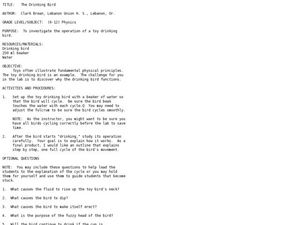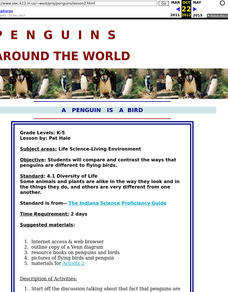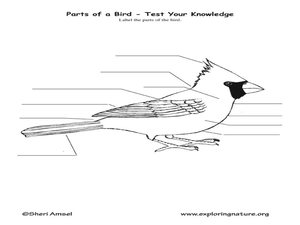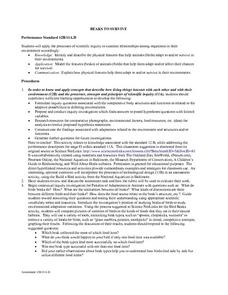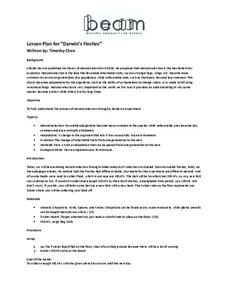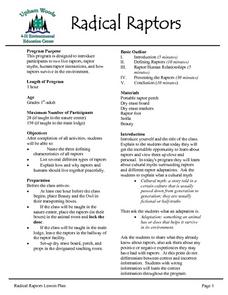Curated OER
The Drinking Bird
Students discover how the "drinking bird" functions. In this investigative lesson, students discover what makes the drinking bird drink by analyzing relative humidity, temperature, and barometric pressure.
Curated OER
The Drinking Bird
Students discover how toys often illustrate fundamental physical principles. The toy drinking bird is an example. The challenge for you in the lab is to discover why the drinking bird functions.
Curated OER
A Penguin is a Bird
Students compare and contrast the ways that penguins are different to flying birds.
Curated OER
Learning Bird Traits
Students draw and label a bird. In this bird traits lesson, students learn what traits make a bird different from other animals. Students are taught how to draw a bird and are expected to label the various body parts they drew.
Curated OER
The Great Horned Owl
In this recognizing facts about the Great Horned Owl worksheet, students read fun facts, match illustrations with adaptations, sequence life cycle cards, and read what to do if they find an injured bird. Students solve 16 answers.
ARKive
Biodiversity and Evolution – Darwin’s Finches
Teens experience natural selection firsthand (or first beak) in an activity that has them act as finches foraging for food. Using different household items to act as different beak styles, your little finches will collect as much food...
Scholastic
Awesome Adaptations
Engaged learners discover how an owl beak works and how animals adapt to their environment. This task is part one of a three-part series.
Curated OER
Eeks Beaks
Seventh graders examine the concept of adaptations that take place in the wild. Birds are the focus organism for this study. They examine the beaks of different birds and point out the differentiations.
Curated OER
Desert Animals
Students are asked if they think a roadrunner is a bird that is a fast runner or a slow runner? They are given a copy of Roadrunner Display Sheet. Students are asked how does a roadrunner protect iteself? They are given the following...
Polar Trec
Swan Savvy
Just like so many other birds, swans migrate during the cold winter months. Your class can gain a better understanding of migration and bird life as they act out some of the activities common to the tundra swan. They make a nest, sit on...
Curated OER
Dancing Flamingos
Learners perform a number of activities that mimic flamingo actions and displays. The class discusses why animals behave in certain ways, and how behavioral adaptations help animals to survive.
Curated OER
Best Nest Builders
Students construct a nest out of mud, string, sticks, and grass using only two fingers or two popsicle sticks to simulate a bird building a nest. They compare/contrast pictures of various bird nests and draw the differences between the...
Curated OER
Beaks To Survive
Students discuss and identify the types of adaptations that are made by different organisms in order for them to survive. In groups, they describe the features of beaks and discuss how it affects their chances for survival. They share...
Curated OER
Kites
Students practice estimating and comparing measurements using yards, feet, and inches. They make comparisons about kites and a variety of measurements. Afterwards, they complete an activity sheet and draw a bird kite with long wings and...
Berkeley Engineering and Mentors
Darwin's Finches
Try a twist on the old finch beak and chopsticks activity by using M&Ms on a Twister mat. Spoons, knives, forks, and chopsticks represent beaks and are randomly assigned to your little birds, who must collect as much food as possible...
Curated OER
Radical Raptors
Students are introduced to raptors and their role in the environment. They identify three characteristics of raptors and list several types of raptors found in nature. They discuss their positive and negative experiences with raptors and...
Curated OER
Matching Objects and Words
In this matching worksheet, students match a set of 3 objects with their names, drawing lines to connect. A reference web site is given for additional activities.
Curated OER
What Kind of Animal Are You?
With the descriptions of six different animal groups (amphibians, birds, fish, insects, mammals, reptiles), students match different examples of animals to their proper groups (lizard to reptiles, girl to mammals, etc). The activity...
Curated OER
The Shape of Things
Sixth graders read and discuss information regarding the shape and attributes of an eggshell. For this shape of things lesson, 6th graders gather relevant information that pertains to the incubation and formation of an eggshell. ...
American Museum of Natural History
Beyond T. Rex
Some dinosaurs get all the attention. Pupils use an interactive resource to study some of the lesser-known dinosaur species. Organizing the information in a cladogram allows learners to make connections among the species.
Curated OER
Toothpick Worms
Young scholars investigate camouflage. In this science lesson plan, students experience the role of color in camouflage as they complete a hands-on activity.
Curated OER
Adaptable Mandibles
Learners define adaptation and highlight example of adaptation in birds and other animals. They study feeding techniques of seabirds and investigate the effect that trash has on wildlife.
Curated OER
Seabird Survival Adaptation Card Game
Learners study seabirds and how they have adapted to their environments. In this activity based lesson students will play a card game that will allow them to have a better understanding of seabirds and their adaptations.
Curated OER
FLY HIGH!!!
Students create their own bird study in their own schoolyard using the scientific method (see Testing a Hypothesis in Join the Project). Students do research in the library, at a local college, or on the Internet to determine the...


